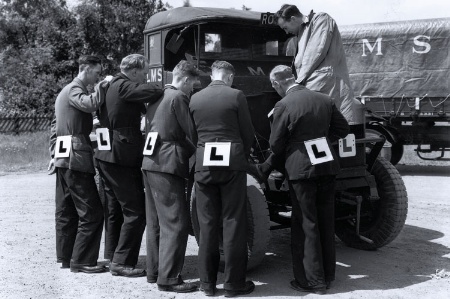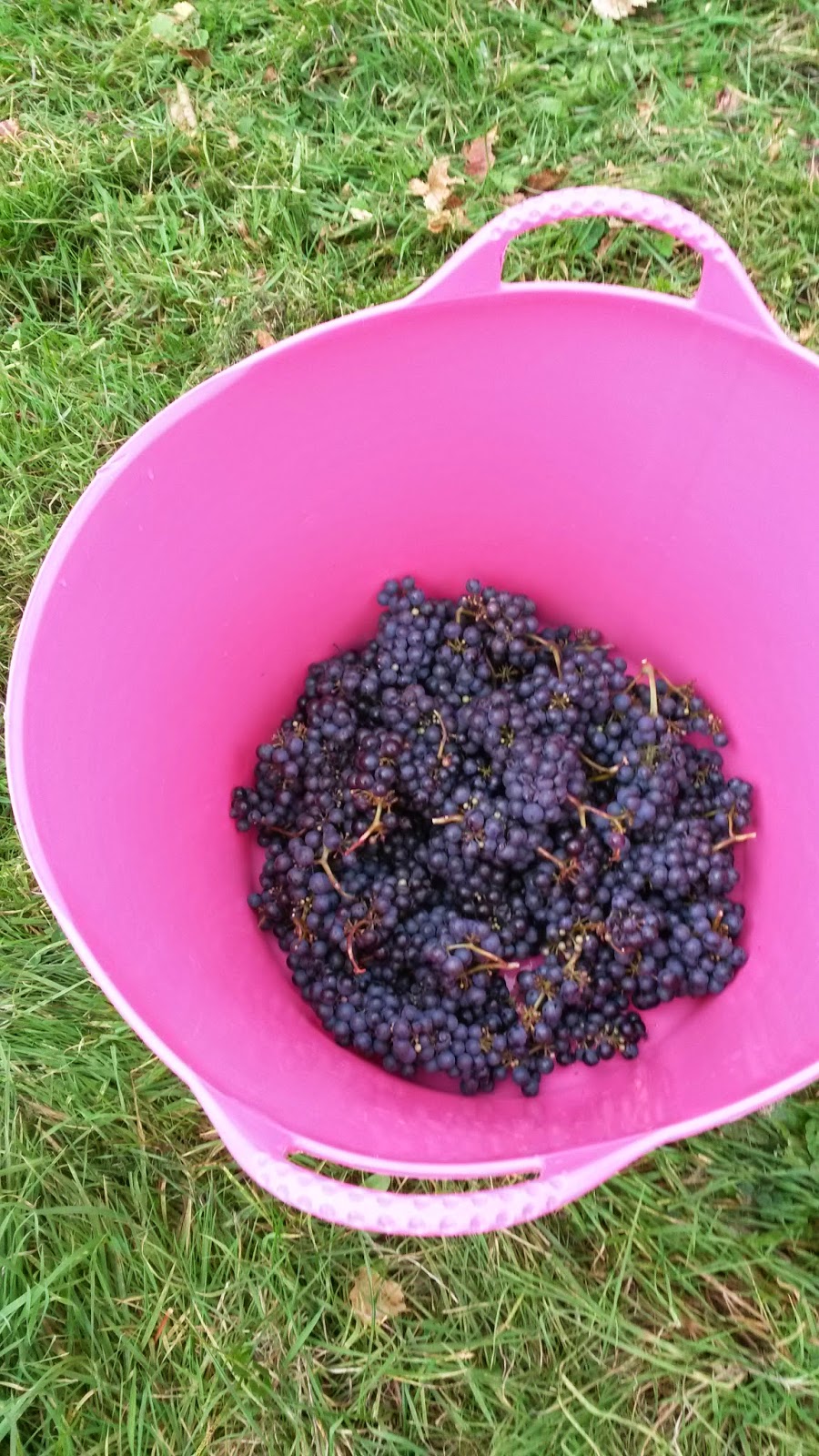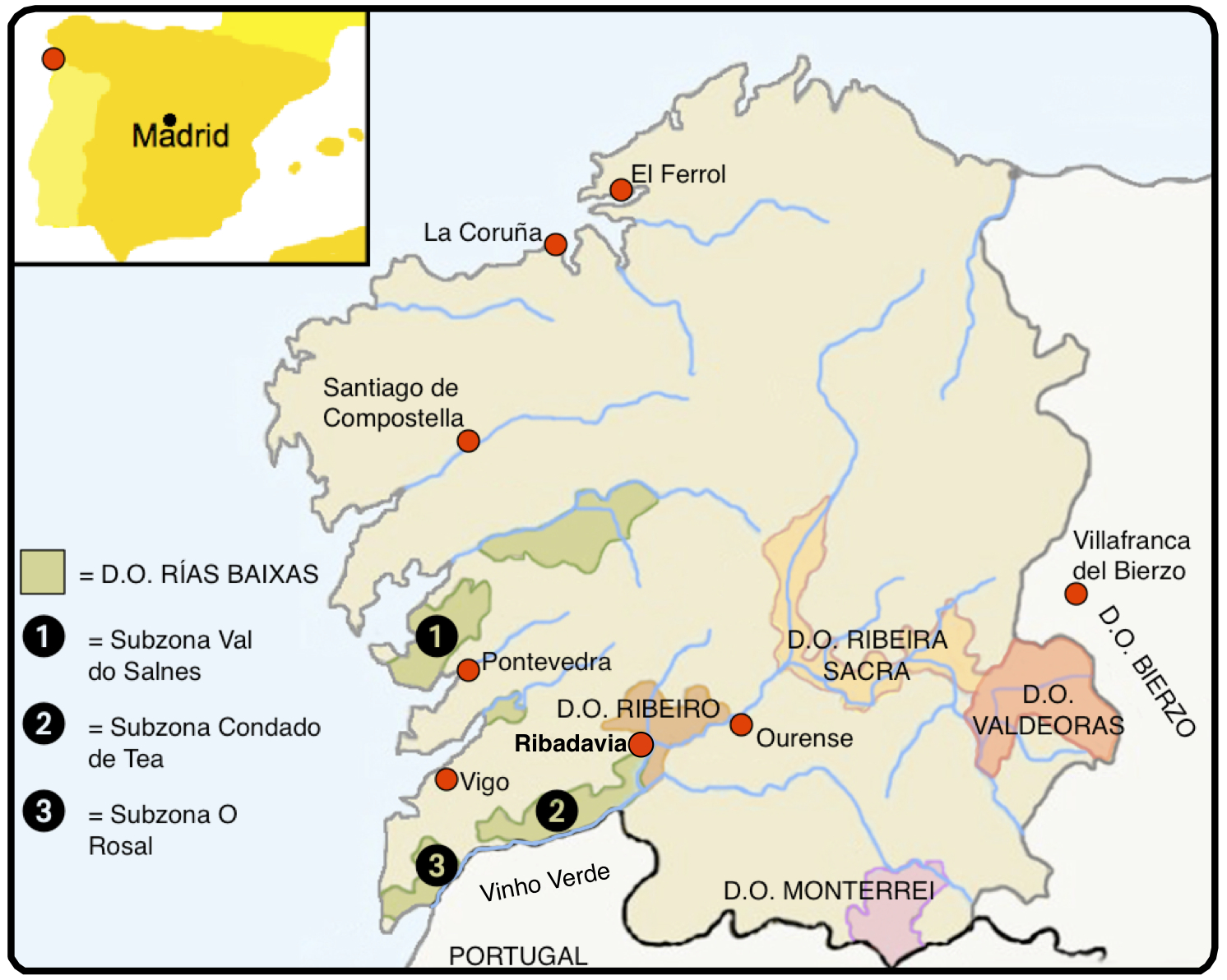'Never again', so said Vince in 2011 on delivery of our Rose from Triomphe d'Alsace. Quite understandable as Vince is a busy man at harvest time making award winning wines for Stanlake Park and a myriad serious professional vineyards in the Thames Valley in quantities many times what we had to offer and from much better grapes.
 |
| a bit of summer pruning |
Three years passed in which we made lovely grape juice but no wine. In one year at least we didn't bother even to do that such was the washout on the weather front. Nevertheless we turned our attention to the Cinderella of our hobby vineyard, the white grapes - Bacchus and planted all sorts of others as an experiment (GM1807-3, Solaris, Goldriesling, Johanniter, Rondo, Regent, Dornfelder, Pinot Noir, Wrotham Pinot and Fruehburgunder. We killed the vegetation between the vines with Round Up and fed the vines with fertiliser for the first time. We also started to spray against Powdery and Downy Mildew and did some radical spur pruning.
 |
| clean and healthy Bacchus |
Our Bacchus seemed to like all this attention and produced grapes - some of them healthy - for the first time in 2013. This year, they produced grapes - most of them healthy - in profusion so we went back to Vince in case he had had a change of mind. He hadn't but being a positive kind of chap he asked 'Why don't you make it yourself?'
 |
| Bacchus with some botrytised berries |
As the time approached we thought it might be worth making an experiment and trying to produce a 'vin naturel'. After all, you didn't really have to do anything. The less you did, the better. If it all went horribly wrong, too bad! We would be no worse off than before.
So in September we hurriedly got a few items from homebrew shops and started watching 'How to' clips on You-Tube and reading up on how to make natural wine. This was confusing to say the least as every recipe was different. Being entirely clueless we had to decide which elements to adopt and which to ignore.
We had actually made a false start in 2013 by crushing our Triomphe and then trying to ferment it as a white wine. It didn't work. This time we had gleaned that there is no danger of oxydisation while the grapes are fermenting. All you have to do is crush them and then leave them for a week or so to ferment by themselves.
We also learned not to press the grapes too officiously as the press wine was less good anyway and we could spare ourselves the considerable effort by using a potato masher in the basket rather than the screw.
We also decided to make two versions each of the Red and the White, one with manipulation including added yeast, fining agents such as Bentonite and Isinglass and SO2 and the other completely without any of these things.
We bought a nice big 60 litre Fermenter with a tap at the bottom which we thought would be handy in racking off the wine from the lees.
When the great day came to harvest the Bacchus we were helped by two itinerant workers and passed through the vineyard taking more or less all the healthy grapes. This was 1 week later than our neighbours at Oaken Grove Vineyard and we thought we detected the odd bit of botrytis on our grapes which hopefully would prevent them from producing undrinkably acidic wine. We put the best grapes through the crusher and put the juice into a fermenter. We then put the solid matter into the basket press and squeezed out more juice with the potato masher.
We had left the less-impressive grapes to do separately. We gave them the same treatment and left them in a separate fermenter.
A wiik later we picked some of the red 'Triomphe' grapes. This time we were without the help of the itinerant workers so it was just us.
 |
| Our Triomphe d'Alsace harvest. 1 man 1 morning. Treading and putting in fermenters in the afternoon. |
The grapes were still in good condition; sweeter than ever before but not having yet been attacked by wasps or birds. The grapes looked blacker than ever and the juice was darker.
 |
| Triomphe trodden by foot. |
This time, not least because no one was looking and inspired by Alice Fering, we decided to tread the grapes instead of putting them through the crusher. We expected the sensation to be both painful and unpleasant but quite the contrary! We then just left the crushed grapes in fermenters.
At the same time we tasted the white wine and decided that fermentation might be underway so we combined the two bins and poured the contents through a fine filter into the big 60 litre fermenter to keep the juice airtight from now on. There was quite a lot of juice left over wich we put into little 5 litre demijohns. At this stage the juice was still a pretty disgusting grey-green colour.
Rather more than a week later we anxiously checked our babies, punching down the caps of the red. There was evidence of fermentation but not of the turbulent kind as so frequently described. On tasting it seemed that things were progressing so we decided to leave things a bit longer. Another week passed and this time the decision was literally to press on and remove the juice from the fermentation bins and potato-mash the solids in the basket press producing enough juice to fill a 25 litre carboy and half another of the same size.
| Triomphe Rose 2010 looks better than it is. |
Then we had an inspiration and opened almost all the remaining bottles of Slotovino Rose 2010 and poured them into the 2014 fermenting juice - same grape, same provenance, just a different year. We could call it our 'NV'.
At this point we made a concerted effort to use the hydrometer we had bought to measure the alcohol level. This is important because you don't know if the fermentation has stopped until the alcohol has reached at least 9 degrees or so. This can only be measured if you have taken readings from the start and can then calculate what progress has been made.
As in all our actions, we were really swimming in the dark. Taste was the best indicator and what we tasted was encouraging - to us at least. Just for an experiment we added the yeast and Bentonite to the 'control' batch of white.
 |
| Mango juice? |
And so it went on with a bit of racking of the white and even at one stage the use of a special yeast for stopped fermentations just in case. When things seemed to have slowed down and the white had cleared to an extent we bought some bottles and corks together with a corker and started bottling. We were sure we were doing this too early and the corks would pop and make a mess all over the place but we were keen to make the wines as 'nouveau' as possible.
 |
| Federweisse/Sturm? |
The whites had the character of 'Federweisse' or 'Sturm' as the new wine is called in Germany and Austria respectively and we wanted the Triomphe to come out with as light a touch as possible as every attempt to make a beast of this beastly grape had seemed doomed as far as previous efforts were concerned.
 |
| a beast even as a baby |
In fact we have never liked any wine made from Triomphe even as lesser part of a blend. Why were we growing it? This would be its last chance.
So what about the results? Opinion had swayed back and forth as to which of our wines might succeed. In the end, only the absolutely natural white was drinkable and not in everyone's opinion. Perhaps we should have given the wines more time in the fermenters? Perhaps we should have put them in oak barrels for a number of years? The red reverted to type after a brief moment of not tasting like Triomphe. It was surprisingly good as Sangria and Gluehwein though. The 'manipulated' white is more acidic then the natural one surprisingly. It went quite well with Thai food (seriously).
The natural white has acquired an amazingly orange colour. It's acidity it also rather overpowering but there is a sweetness there at the same time. The two haven't got together to make a whole but perhaps they will marry up in time?








































































